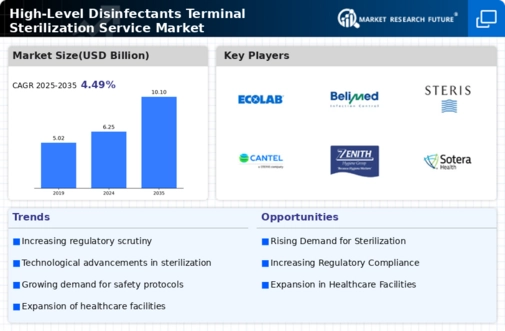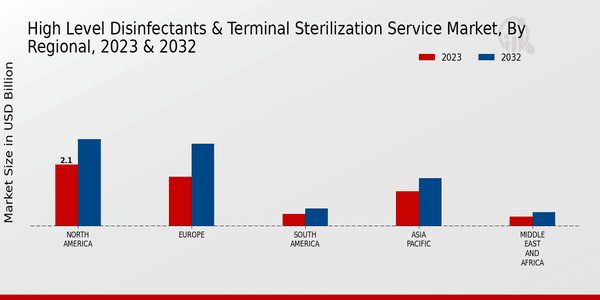Regulatory Pressures and Compliance
The High-Level Disinfectants Terminal Sterilization Service Market is significantly influenced by regulatory pressures and compliance requirements. Governments and health organizations are establishing stringent guidelines for disinfection practices, compelling healthcare facilities to adopt high-level disinfectants and terminal sterilization services. Compliance with these regulations is not only essential for patient safety but also for avoiding potential legal repercussions. As a result, many facilities are investing in advanced sterilization technologies to meet these standards. The market is likely to expand as more organizations recognize the importance of adhering to these regulations, which are expected to evolve further in response to emerging health threats.
Increased Focus on Infection Control
The High-Level Disinfectants Terminal Sterilization Service Market is witnessing an increased focus on infection control measures across various sectors. Healthcare facilities are prioritizing stringent sterilization protocols to mitigate the risk of healthcare-associated infections (HAIs). This heightened awareness is leading to a greater demand for high-level disinfectants and terminal sterilization services. According to recent data, the prevalence of HAIs has prompted healthcare providers to invest more in disinfection services, with the market expected to reach a valuation of several billion dollars by the end of the decade. This trend underscores the critical role that effective sterilization plays in maintaining patient safety and overall public health.
Growing Awareness of Environmental Safety
The High-Level Disinfectants Terminal Sterilization Service Market is also influenced by a growing awareness of environmental safety and sustainability. As concerns about the environmental impact of chemical disinfectants rise, there is a shift towards eco-friendly alternatives that do not compromise on effectiveness. This trend is prompting manufacturers to innovate and develop high-level disinfectants that are both effective and environmentally safe. The market is likely to see an increase in demand for such products as consumers and organizations prioritize sustainability in their purchasing decisions. This shift not only aligns with global sustainability goals but also enhances the reputation of companies that adopt environmentally responsible practices.
Technological Innovations in Disinfection
The High-Level Disinfectants Terminal Sterilization Service Market is experiencing a surge in technological innovations that enhance the efficacy of disinfection processes. Advanced technologies such as automated disinfection systems and ultraviolet (UV) light sterilization are becoming increasingly prevalent. These innovations not only improve the speed and effectiveness of sterilization but also reduce human error, thereby increasing safety in healthcare settings. The market for high-level disinfectants is projected to grow significantly, with estimates suggesting a compound annual growth rate of over 10% in the coming years. This growth is driven by the need for more efficient and reliable sterilization methods, particularly in hospitals and clinics where infection control is paramount.
Rising Demand from the Pharmaceutical Sector
The High-Level Disinfectants Terminal Sterilization Service Market is experiencing rising demand from the pharmaceutical sector, which requires stringent sterilization processes to ensure product safety and efficacy. Pharmaceutical manufacturers are increasingly adopting high-level disinfectants to maintain sterile environments in production facilities. This trend is driven by the need to comply with regulatory standards and to prevent contamination during the manufacturing process. The market for terminal sterilization services is projected to grow as pharmaceutical companies expand their operations and seek reliable disinfection solutions. This demand is expected to contribute significantly to the overall growth of the market, with projections indicating a robust increase in service utilization over the next few years.



















Leave a Comment